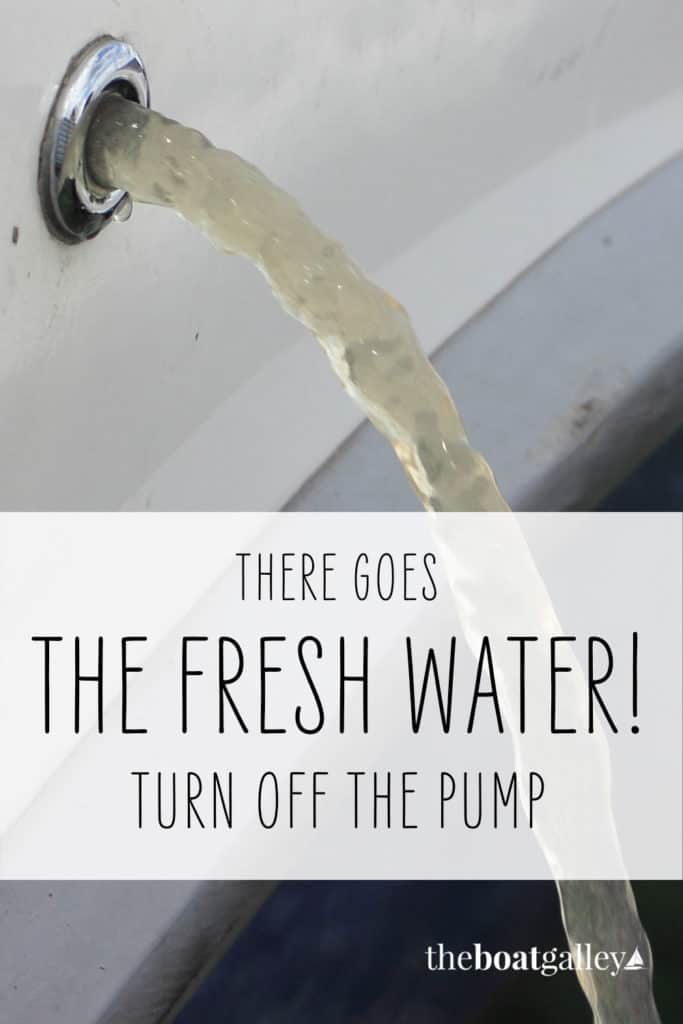
Why should you turn off the water pump on your boat? The answer comes from a “Voice of Experience” article in SAIL magazine (read it here).
One Small Clamp; One Big Problem
In brief, it’s the story of a fresh water hose clamp that came loose while underway from Florida to the Bahamas. With the clamp loose, the pressure switch on the freshwater pump kept the pump on — pumping all the water from the tank into the bilge and threatening the batteries and engine.
The engine noise — and then the bilge pump noise — obscured what was happening, so that the owners didn’t initially realize what the problem was.
Lessons Learned
So, three basic tips from this:
- Turn off the fresh water pump when you’re not using it. You might leave it on as you’re preparing a meal and doing dishes, but turn it off afterwards. Particularly if you’re leaving the boat (even just for a few minutes to visit another boat, running errands, a walk on the beach, whatever). And underway when you may be in the cockpit and regular boat noises can make it hard to hear the pump running.
- A bilge alarm or noise that goes off when the bilge pump runs (we had a very obnoxious “whooper” wired into the big pump) costs little and can alert you to a problem before you’d notice it otherwise. See our bilge alarm here.
- If you have unexpected amounts of water in the bilge, the first thing to do is check if it’s salt or fresh if you’re in salt water. Even in fresh water, you can often tell if it’s tank water or lake/river water from the taste.
Fresh Water vs Sea Water
When motoring, you may get a little water in the bilge from the packing gland. For us, it meant that if we didn’t run the “little” bilge pump (we had two — one large capacity that was mounted higher in the bilge and wired with a float switch and alarm, and one smaller one with only a manual switch and no alarm, with the intake in the very bottom of the bilge) every few hours, the big pump would go off after about 4 hours of motoring.
We learned that if we were motoring, we should run the little bilge pump every hour when we made our log entries and at the end of a trip. That took care of the packing gland drip. And that made it so that when the whooper went off, we knew we had a problem.
Bilge Alarm Goes Off
Twice it did go off in the middle of the night. And yes, we woke in an absolute panic. The fact that the pump turned off after about 30 seconds calmed us slightly — obviously the pump could keep up. With one, the taste test revealed it was fresh water and we discovered a pinhole leak in our freshwater tank. The other was salt water and turned out to be a problem when the stuffing box (which contains the packing gland) had been removed and reinstalled on a haul out — we had just relaunched.
Turning off the freshwater pump when you’re not using it reduces the possibilities of a problem occurring. And if you only turn it on when you need it, you’ll immediately realize that you have a problem if you turn it on — without a faucet open — and it starts running and doesn’t quickly stop (often, it’ll run a few seconds when you first turn it on).
Yes, we had that happen too. And we were able to find the problem fairly quickly — a faulty pressure switch in the pump — as we were able to verify that no water was flowing into the bilge. That meant that there wasn’t a loose connection or hole/crack in a hose. We could easily see that there wasn’t a leaking faucet. Changing out the pump — we had a duplicate in our spares — took only about 30 minutes and solved the problem.
Okay, that last part was a bit of a digression from the main point of this post — a good “standard operating procedure” in the galley — but it’s a good example of how you can troubleshoot a problem such as this.
Related Posts
Flatten the learning curve with practical how-to info that gives you the confidence to step into life aboard.
Start Learning Today

Carolyn Shearlock has lived aboard full-time for 17 years, splitting her time between a Tayana 37 monohull and a Gemini 105 catamaran. She’s cruised over 14,000 miles, from Pacific Mexico and Central America to Florida and the Bahamas, gaining firsthand experience with the joys and challenges of life on the water.
Through The Boat Galley, Carolyn has helped thousands of people explore, prepare for, and enjoy life afloat. She shares her expertise as an instructor at Cruisers University, in leading boating publications, and through her bestselling book, The Boat Galley Cookbook. She is passionate about helping others embark on their liveaboard journey—making life on the water simpler, safer, and more enjoyable.










The Boat Galley says
Ouch!
Carolyn Shearlock says
Great idea!
Richard Harper says
I had a seal failure which allowed the water to back up into the motor and ruin it. Now I turn off the pump and release the pressure in the water system before leaving the boat for extended periods.
Julie Olson says
Gotta disagree on this one. We’ve never had a significant (other than a very occasional dribble) leak problem with our pressure water system in ~23 years. Nor our circle of >50 multi-year cruising friends. It would be quite annoying to have to turn the pressure water breaker on and off for head use, especially with guests aboard. Because we have an autoflush feature on our watermaker, we do keep the pump’s breaker on even when leaving for a few weeks at a time as every cycle needs about 5 gallons FW every 5 days.
I think the much more serious problem not addressed in the article was a failure of their automatic bilge pump to push the leakage out of the boat – especially if they had instead experienced a seawater leak – and the need for an adequately loud and effective high water alarm to alert them that the bilge pump was notbworking.